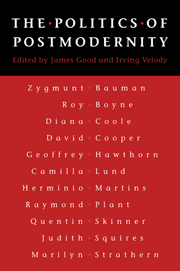Book contents
- Frontmatter
- Contents
- Acknowledgements
- Notes on contributors
- 1 Introduction: postmodernity and the political
- Part I Modernity and its vicissitudes
- Part II The critique of modernist political thought
- Part III Technology and the politics of culture
- 9 Technology, modernity, politics
- 10 Surrogates and substitutes: new practices for old?
- 11 Postmodernism, the sublime and ethics
- Index
10 - Surrogates and substitutes: new practices for old?
Published online by Cambridge University Press: 05 June 2012
- Frontmatter
- Contents
- Acknowledgements
- Notes on contributors
- 1 Introduction: postmodernity and the political
- Part I Modernity and its vicissitudes
- Part II The critique of modernist political thought
- Part III Technology and the politics of culture
- 9 Technology, modernity, politics
- 10 Surrogates and substitutes: new practices for old?
- 11 Postmodernism, the sublime and ethics
- Index
Summary
In commenting on the way surrogacy has appeared at the eye of the storm surrounding assisted conception, Derek Morgan records a complaint. It is not his; it comes from those who would wish to defend even in these circumstances what he presumes most would also wish to defend in general: the legal understanding that takes the mother of a child to be she who gives birth to it. The complaint is that parenthood has instead become defined as ‘genetic and intrafamilial’. In this view, ‘genetic niceties’ should not stand in the way of recognising the authenticity of gestational mother: the person ‘who takes and rears the child rather than she who gives birth is properly the surrogate. The woman giving birth is the mother’ (paraphrased by Morgan, 1989: 56, his emphasis). Nelson and Nelson (1989: 86) point out that the current OED definitions of ‘mother’ (woman who has given birth) and ‘surrogate’ (one who acts in the place of another) would suggest that the surrogate is the woman to whom the child is surrendered. Yet popular usage seems determined to have it the other way round. The term surrogate appears irrevocably and stubbornly tied to the woman who in these circumstances bears the child. There are, I shall suggest, some interesting reasons for that stubbornness.
Morgan, whose field is health-care law in Britain, stresses the familial as well as genetic presumptions here. He regards surrogacy itself ‘as a by-product of the industry which has created the nuclear family’ (1989: 55; and see Haimes, 1990).
- Type
- Chapter
- Information
- The Politics of Postmodernity , pp. 182 - 209Publisher: Cambridge University PressPrint publication year: 1998
- 2
- Cited by



